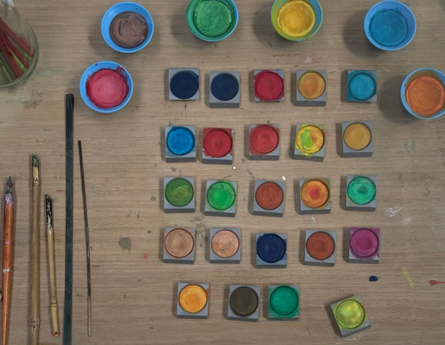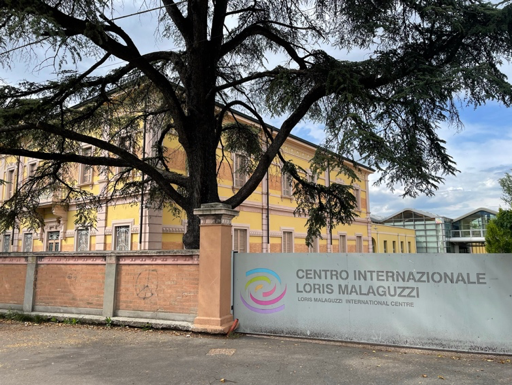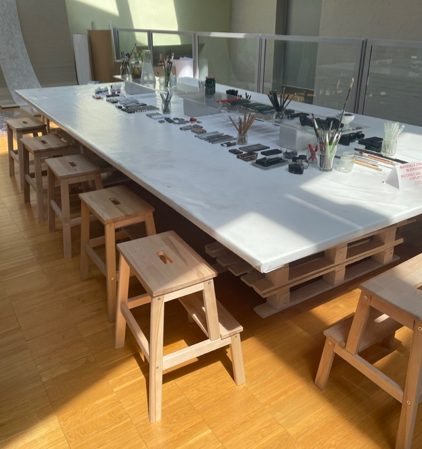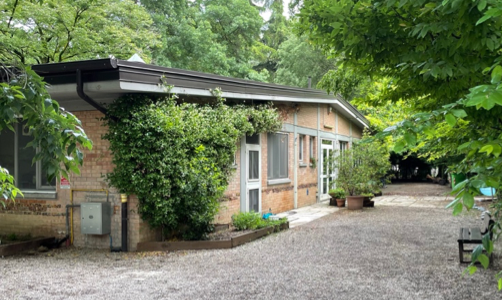Reggio Children-May 31, 2023
After my visit to Maria Montessori’s first school in Rome, I was eager to learn more about the Reggio Emilia approach to early childhood education and find out how Montessori and Reggio compare, especially considering these two now global learning approaches originated from the same country. What I came to realize is that the two share philosophical values about child development, yet the materials, environment, and day-to-day happenings can look quite different, particularly with respect to language and literacy.
 Situated between Parma (known for its delicious Parmigiano Reggiano cheese) and Modena (the birthplace of Luciano Pavarotti and where you can find the best balsamic vinegar), Reggio Emilia is a relatively small and quiet city located in the northern region of Italy. It’s where early childhood educator, Loris Malaguzzi initiated the Reggio approach. Malaguzzi believed that all children are naturally curious, capable of constructing their own learning in an environment that invites them to collaborate with their peers and provides them with a sense of ownership and autonomy. Project-learning, inquiry, and documentation are important components of any Reggio classroom along with a general philosophy that children are able to express themselves through their “hundred languages”. This term, “hundred languages” was first used by Malaguzzi in a poem he wrote and has since become a key principle of the Reggio approach. It refers to communication and emphasizes the importance of providing children with one hundred ways (or more) to share their thinking of the world around them. Loris Malaguzzi worked together with the city of Reggio Emilia and several local administrators and citizens to develop a network of municipal infant-toddler centres and preschools, the first of which opened in 1963. Recognition of the Reggio approach grew after an exhibition of educational projects from the centres and preschools in 1994. Just over a decade later, in 2006, the Loris Malaguzzi International Centre opened.
I had the pleasure of visiting the Centre multiple times during my visit to Reggio Emilia. On one of those visits, I joined a group of educators for a guided tour of the Centre. Several areas of that we passed through were dedicated spaces to specific projects. These spaces are known as ateliers, environments meant to promote knowledge and creativity; studios where the children work on inquiry projects alongside an atelierista, a teacher with an arts background. The guide noted that the atelier is a crucial centre for children’s research. The Ray of Light Atelier, for instance, is a place where the children investigated light, experimenting with different colours, objects, and light projections to deepen their understanding of light. Spaces like the Ray of Light Atelier are meant to evoke children’s curiosity, and provide them with opportunities to create, explore, and converse with each other and their teachers.
Situated between Parma (known for its delicious Parmigiano Reggiano cheese) and Modena (the birthplace of Luciano Pavarotti and where you can find the best balsamic vinegar), Reggio Emilia is a relatively small and quiet city located in the northern region of Italy. It’s where early childhood educator, Loris Malaguzzi initiated the Reggio approach. Malaguzzi believed that all children are naturally curious, capable of constructing their own learning in an environment that invites them to collaborate with their peers and provides them with a sense of ownership and autonomy. Project-learning, inquiry, and documentation are important components of any Reggio classroom along with a general philosophy that children are able to express themselves through their “hundred languages”. This term, “hundred languages” was first used by Malaguzzi in a poem he wrote and has since become a key principle of the Reggio approach. It refers to communication and emphasizes the importance of providing children with one hundred ways (or more) to share their thinking of the world around them. Loris Malaguzzi worked together with the city of Reggio Emilia and several local administrators and citizens to develop a network of municipal infant-toddler centres and preschools, the first of which opened in 1963. Recognition of the Reggio approach grew after an exhibition of educational projects from the centres and preschools in 1994. Just over a decade later, in 2006, the Loris Malaguzzi International Centre opened.
I had the pleasure of visiting the Centre multiple times during my visit to Reggio Emilia. On one of those visits, I joined a group of educators for a guided tour of the Centre. Several areas of that we passed through were dedicated spaces to specific projects. These spaces are known as ateliers, environments meant to promote knowledge and creativity; studios where the children work on inquiry projects alongside an atelierista, a teacher with an arts background. The guide noted that the atelier is a crucial centre for children’s research. The Ray of Light Atelier, for instance, is a place where the children investigated light, experimenting with different colours, objects, and light projections to deepen their understanding of light. Spaces like the Ray of Light Atelier are meant to evoke children’s curiosity, and provide them with opportunities to create, explore, and converse with each other and their teachers.

 Dialogue and interactions indeed promote language and help foster vocabulary development, in an implicit way, although the teacher may have particular goals in mind or new vocabulary they are interested in explicitly teaching to the children, all within the context of a project. Within each atelier are documentations of the children’s work, describing how the project and the children’s learning progressed. The different languages are also described—in the Ray of Light Atelier children investigated the topic through their words, drawings, sounds, constructions, and visual compositions. These different languages are similar to what we might refer to as multiliteracies, a term most familiar to educational researchers in North America. Multiliteracies refers to the multimodal forms of expression and representation, and moves beyond more traditional forms of literacy like reading and writing. Interestingly, this term was not used at the Centre or in any of my conversations with educators and teachers.
One of the main schools in Reggio Emilia is the Diana School, likely the most popular school in the city. It resides in the city centre’s park, a purposefully selected space by Malaguzzi himself. Any passerby can hear the children playing and working, creating and investigating, within and around the school walls. I was able to access documentations of the children’s various projects over the years at the Centre (at least the ones that had been translated into English). These were mostly in the form of books and included both the children’s voices through their drawings, direct quotes, and written passages, and the teacher’s narratives describing the children’s inquiry process. The first book I picked up, for example, was entitled Light: Children’s Thoughts, Images, and Explorations. The children’s inquiry questions, like “What is light made of?” filled parts of the book. The children’s ideas and related theories were also presented poetically on the page. Some of the children’s illustrations were incorporated, and many photos of various experiments in which the children participated were included. The children’s narratives were captured verbatim demonstrating and highlighting the importance of representing their voices.
Dialogue and interactions indeed promote language and help foster vocabulary development, in an implicit way, although the teacher may have particular goals in mind or new vocabulary they are interested in explicitly teaching to the children, all within the context of a project. Within each atelier are documentations of the children’s work, describing how the project and the children’s learning progressed. The different languages are also described—in the Ray of Light Atelier children investigated the topic through their words, drawings, sounds, constructions, and visual compositions. These different languages are similar to what we might refer to as multiliteracies, a term most familiar to educational researchers in North America. Multiliteracies refers to the multimodal forms of expression and representation, and moves beyond more traditional forms of literacy like reading and writing. Interestingly, this term was not used at the Centre or in any of my conversations with educators and teachers.
One of the main schools in Reggio Emilia is the Diana School, likely the most popular school in the city. It resides in the city centre’s park, a purposefully selected space by Malaguzzi himself. Any passerby can hear the children playing and working, creating and investigating, within and around the school walls. I was able to access documentations of the children’s various projects over the years at the Centre (at least the ones that had been translated into English). These were mostly in the form of books and included both the children’s voices through their drawings, direct quotes, and written passages, and the teacher’s narratives describing the children’s inquiry process. The first book I picked up, for example, was entitled Light: Children’s Thoughts, Images, and Explorations. The children’s inquiry questions, like “What is light made of?” filled parts of the book. The children’s ideas and related theories were also presented poetically on the page. Some of the children’s illustrations were incorporated, and many photos of various experiments in which the children participated were included. The children’s narratives were captured verbatim demonstrating and highlighting the importance of representing their voices.
 The second book I opened was entitled The Grape Tree, and documented children’s thoughts and illustrations related to their grape vineyard and the observations they made throughout the seasons. The book recalled the children’s experiences through photos of their explorations and field trips. Their theories and hypotheses were presented through their illustrations. As with all the documentations and artefacts, this was a collective work, in which learning occurred together, through experimentation and observation, sometimes guided by the teacher and often led by the children.
Malaguzzi’s ideas about language and communication stem from sociocultural theories and perspectives about child development. Through interactions, dialogue, and children being together, the children construct and reconstruct their knowledge about the world around them. Language and literacy are interwoven throughout their projects and day-to-day happenings. The children take a constructive role in the process of knowledge building; they’re encouraged to recognize reading and writing as much more than learning the alphabet. There might, indeed, be components of more explicit and direct instruction. For instance, a teacher telling the children about a new vocabulary word, or supporting the child as they encode a word they are writing, paying attention to each sound in the word and representing the sounds with the correct letter or combination of letters. Most of the time, however, language and literacy are implicitly learned through conversations, and real-world reading and writing activities. This seems to be the main difference between Reggio and Montessori, where reading and writing instruction in Montessori classrooms seems to be quite direct and systematic.
Perhaps the implicit nature of the Reggio approach works best with languages like Italian, which is considered a more transparent language (there is a one-to-one relationship between its graphemes, the letter symbols, and phonemes, the letter sounds), and so the spelling of words is consistent. That’s not to say that an English speaking classroom can’t be Reggio-inspired, perhaps blending the inquiry approach with more direct and systematic instruction in reading and writing. The Reggio approach has in fact reached over 34 countries, and project learning, inquiry-based schools, and the philosophy of following children’s natural curiosity can certainly be seen across countries and educational contexts (for instance, The Jackman Institute of Child Study Laboratory School in Toronto).
Leaving Reggio Emilia, I felt inspired to consider how aspects of both Montessori and Reggio approaches can be included in any early years classroom. I also found myself reflecting on my own teaching practices, with teacher candidates and graduate students. As I begin to plan for fall courses, I will be thinking about my visits and interactions with teachers over this past year, and how my own learning about language and literacy practices across contexts has evolved.
-Pamela
The second book I opened was entitled The Grape Tree, and documented children’s thoughts and illustrations related to their grape vineyard and the observations they made throughout the seasons. The book recalled the children’s experiences through photos of their explorations and field trips. Their theories and hypotheses were presented through their illustrations. As with all the documentations and artefacts, this was a collective work, in which learning occurred together, through experimentation and observation, sometimes guided by the teacher and often led by the children.
Malaguzzi’s ideas about language and communication stem from sociocultural theories and perspectives about child development. Through interactions, dialogue, and children being together, the children construct and reconstruct their knowledge about the world around them. Language and literacy are interwoven throughout their projects and day-to-day happenings. The children take a constructive role in the process of knowledge building; they’re encouraged to recognize reading and writing as much more than learning the alphabet. There might, indeed, be components of more explicit and direct instruction. For instance, a teacher telling the children about a new vocabulary word, or supporting the child as they encode a word they are writing, paying attention to each sound in the word and representing the sounds with the correct letter or combination of letters. Most of the time, however, language and literacy are implicitly learned through conversations, and real-world reading and writing activities. This seems to be the main difference between Reggio and Montessori, where reading and writing instruction in Montessori classrooms seems to be quite direct and systematic.
Perhaps the implicit nature of the Reggio approach works best with languages like Italian, which is considered a more transparent language (there is a one-to-one relationship between its graphemes, the letter symbols, and phonemes, the letter sounds), and so the spelling of words is consistent. That’s not to say that an English speaking classroom can’t be Reggio-inspired, perhaps blending the inquiry approach with more direct and systematic instruction in reading and writing. The Reggio approach has in fact reached over 34 countries, and project learning, inquiry-based schools, and the philosophy of following children’s natural curiosity can certainly be seen across countries and educational contexts (for instance, The Jackman Institute of Child Study Laboratory School in Toronto).
Leaving Reggio Emilia, I felt inspired to consider how aspects of both Montessori and Reggio approaches can be included in any early years classroom. I also found myself reflecting on my own teaching practices, with teacher candidates and graduate students. As I begin to plan for fall courses, I will be thinking about my visits and interactions with teachers over this past year, and how my own learning about language and literacy practices across contexts has evolved.
-Pamela

Reggio Children-May 31